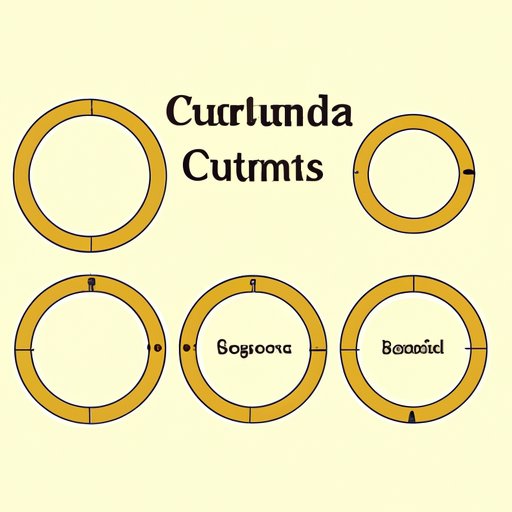
Introduction
Have you ever been tasked with measuring the length around an object for a project or assignment? The ability to find circumference is a crucial skill for math, science, and engineering fields. This article will provide you with a comprehensive guide to finding circumference, including step-by-step instructions and real-life applications.
Step-by-Step Guide: How to Find Circumference of Any Object
Circumference is defined as the distance around a circle or rounded object. The formula for finding the circumference, C, of a circle is C = πd or C = 2πr, where d is the diameter and r is the radius.
To find the circumference of a circle using the diameter, the formula is C = πd. Simply take the diameter of the circle and multiply it by π (approximately 3.14). For example, if the diameter of a circle is 10 centimeters, the circumference would be 10 x 3.14 = 31.4 centimeters.
To find the circumference of a circle using the radius, the formula is C = 2πr. Simply take the radius of the circle and multiply it by 2π. For example, if the radius of a circle is 5 centimeters, the circumference would be 2 x 3.14 x 5 = 31.4 centimeters.
Mastering the Basics: A Beginner’s Guide to Calculating Circumference
Before you can accurately calculate the circumference of a circle, it is important to know how to measure the diameter or radius. To measure the diameter, simply measure the distance across the circle, passing through the center. To measure the radius, measure half the distance from one side of the circle to the center.
An easy way to remember the relationship between diameter and radius is that the diameter is twice the length of the radius. Once you have measured the diameter or radius, use the corresponding formula to find the circumference.
Practice Exercises:
1. Measure the diameter of a circle with a radius of 8 centimeters. Find the circumference.
2. Measure the radius of a circle with a diameter of 30 inches. Find the circumference.
Circles Unraveled: How to Solve for Circumference Like a Pro
While the previous examples have demonstrated how to find the circumference of a basic circle, more complicated scenarios may require additional steps. For example, if you need to find the circumference of a sector (a section of a circle), you would first need to find the degree measure of the sector, and then use the formula C = 2πr x (degree measure/360).
Another scenario may involve finding the circumference given other measurements, such as the area or arc length of a circle. In these cases, you would use different formulas and algebraic equations to solve for the unknown variable.
Advanced Tip: Memorize the value of pi (π) to at least three decimal places for quick and accurate calculations.
Unlocking the Mystery: Tips and Tricks for Finding Circumference Without Breaking a Sweat
While the formulas provided in this article offer standard methods for finding circumference, there are alternative ways to approach the problem. For example, cutting out a strip of paper that fits around the object and measuring the length can give an approximate circumference measurement.
Real-life applications of finding circumference include calculating the amount of fencing needed for a circular garden, determining the length of wire needed to wrap around a spool, and calculating the distance traveled by a wheel on a vehicle.
Beyond the Formula: Understanding the Concept of Circumference with Ease
Understanding the concept of circumference can lead to a better appreciation of circular objects in the world around us. Circumference represents the distance around the edge of a circle, which can help us calculate the length of objects and even measure the speed of rotating machinery.
Real-world examples of the importance of knowing circumference include calculating the distance around a bicycle wheel, determining the size of a circular frame for a painting, and designing circular jewelry.
Conclusion
In conclusion, finding circumference is an essential skill for a wide range of fields and everyday life. By understanding the formulas, measuring techniques, and real-life applications of circumference, you can master this concept and solve any related problem with ease. Be sure to try the practice exercises, and seek further resources if needed, to continue improving your skills.




